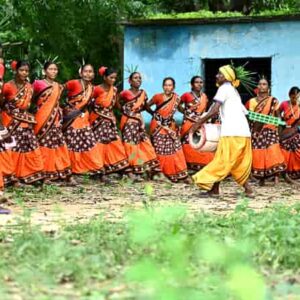The natives of Kerala are highly fond of their cultural heritage and leave no stone unturned to preserve it. The unique beauty of God’s own country is reflected through the glistening backwaters, swaying virgin coconut palms, and the Kerala dance forms. The state locals show their love of the traditional dance forms during festivities and cultural events. The various folk dances of Kerala are performed in accompaniment of Carnatic or classical music, and the performances will definitely leave you in awe of the performers.
There are over 50 traditional Kerala dance forms. Of those 50 varieties, Kathakali is the most well-known and famous dance form. The various Kerala dance forms are popular not only within the state but also in the entire world. Each dance form is unique in its own way and comes with different kinds of expressions. One dance form differs from another in terms of gestures, costumes, get-ups, and adornments. Interestingly enough, the folk dances of Kerala have their roots in the classical dances and strong beliefs in the various mythological tales.
Read below to learn about the folk dances of Kerala in detail:
1. Kathakali
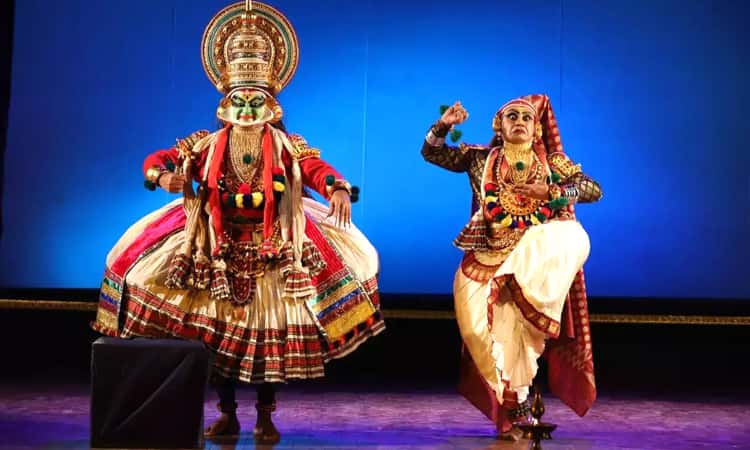
We all know about the Kathakali dance form. The typical get-up of the dancers and the way they express themselves make this dance famous worldwide. The history of this dance form dates back to some 500 years. From makeup to costume to performance, there is an unmistakable dramatic element about Kathakali. The dance shows a unique fusion of design, art, music, and religion. Kathakali is basically a male-dominated dance form. The performers usually enact various roles from the Mahabharata, Ramayana, and Puranas. The performers of Kathakali wear colourful attires. One notable attribute of this dance form is that it uses plenty of eye movements and muscle movements.
2. Thirvathirakali
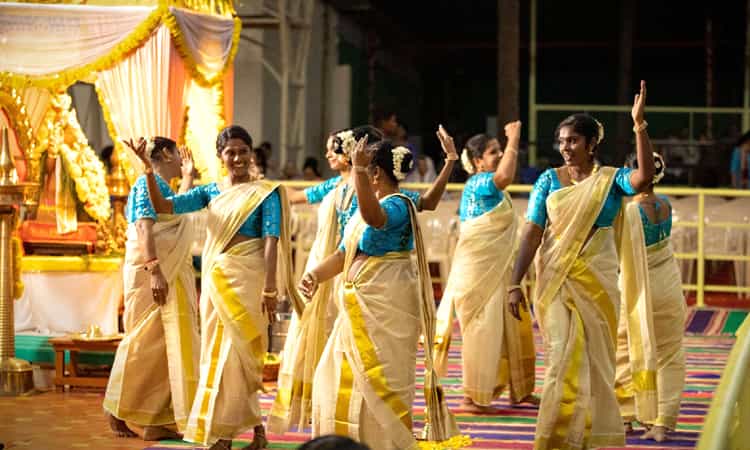
Women perform this dance during the Onam. A group of women perform this dance to celebrate the harvest times of Onam. They perform this dance by moving in a circular pattern and praying for fecundity and marital bliss. This dance is performed in the month of Dhanu as per the Malayalam calendar. During the dance, women move around a floral decoration or a lamp, clapping their hands and singing.
3. Kolkali
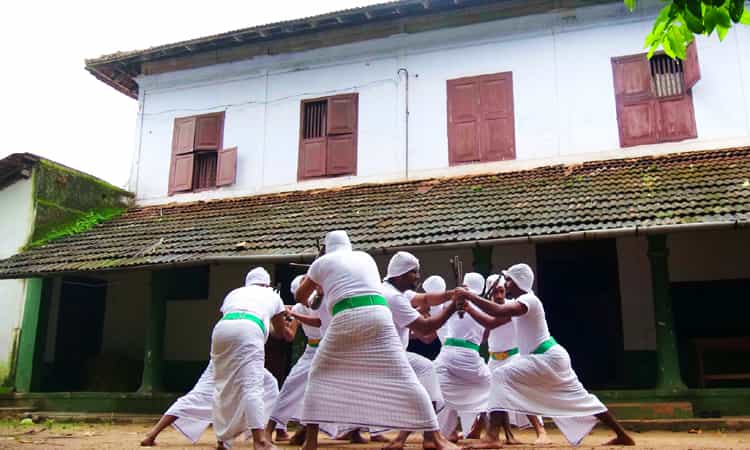
The people of the farming community of Kerala perform this particular dance. 24 performers come together to execute this dance form. 2 ft long wooden sticks are used as a prop for this dance. The performers of this dance move around in a circular pattern, tapping their sticks loudly. A ceremonial lamp is lit for this dance, and the performers move around the lamp. This extremely rhythmic dance form is usually performed in the villages of Kerala.
Must Read: Folk Dance of Rajasthan
4. Theyyam

In Kerala’s Malabar region, this dance form is practiced. Nearly 456 categories of Theyyam exist in the state, out of which the most famous ones are Manakkott Amma, Gulikan, Kathivanur Veeran, and Sree Muthappan Theyyam.
5. Nangiar Koothu Dance

This dance form is basically a dance drama getting inspiration from the Sanskrit dance drama culture. Women of Kerala participate in this dance form. Women belonging to the Ambalavasi Nambiar community take part in this dance. The dances are based on Hindu mythological texts and mostly cover stories from the life and era of Lord Krishna. The dancers present the theme through unique facial expressions and hand movements.
6. Margamkali
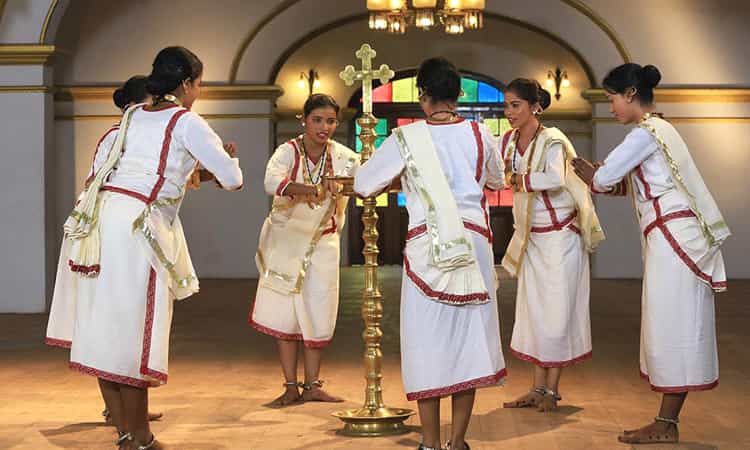
The Syrian Christians residing in the state of Kerala perform this dance. This dance form has evolved from the Kalaripayattu. Twelve performers perform this dance by going around a Vilakku. This dance form is often used for the propagation of Christianity. The 12 dancers in the dance symbolize the 12 apostles of Lord Jesus. The lighted lamp around which the performers dance stands out as a symbol of Lord Jesus. No musical instruments are used in this dance. The song with which the performers dance is generally very old.
7. Oppana
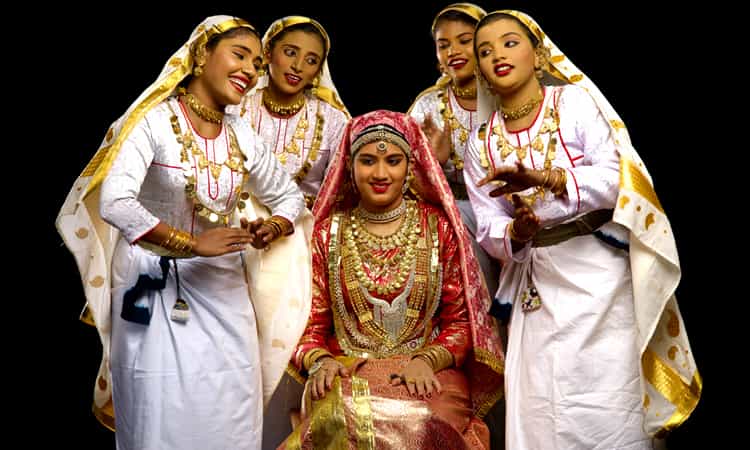
This dance form is highly popular among the Muslim communities residing in the Malabar region of Kerala. This performance is generally seen during a Muslim wedding, where the bride’s female relatives sing and perform this dance by moving around the bride. The performers clap their hands as they dance.
Must Read: Folk Dance of Assam
8. Chakyar Koothu

This is an ancient dance form of Kerala. This dance is performed inside the premises of a temple or inside the Koothambalam, a special kind of theatre. This dance depicts various scenes from the Puranas, Mahabharata, and Ramayana. The performers use various expressions and gestures to enact their part. This is an ancient dance form and is said to have been introduced by the Aryans. This dance form is exclusive to the Chakyar caste of Kerala.
9. Koodiyattam
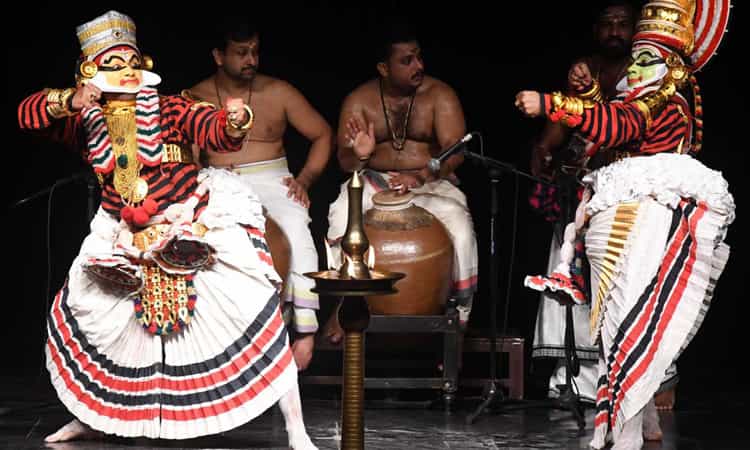
Koodiyattam is a popular dance form in Kerala. Performance of this dance usually took place within the temple’s premises for several centuries. It was performed in accompaniment of musical instruments such as Kurumkuzhal, Kuzhitalam, Sankhu, and Mizhavu.
10. Ottamthullal

The origin of this dance form may be traced back to the 18th century. This dance form is said to have been created by the famed Malayalam poet Kalakkaththu Kunchan Nambiar. This dance form is usually a group dance. The dancers wear vibrant costumes and gaudy makeup. Through the dance form, the dancers tell the stories of mythology.
11. Velakali

This is a martial art-based dance form performed during temple festivals. People of the Nair community perform this dance. The performers don colourful clothes and carry weapons like shields and swords while performing this dance. The dance sequence is planned in such a way that it replicates the fierce battle of Mahabharata fought between the Pandavas and Kauravas. During this dance performance, mammoth effigies symbolizing the Pandavas are put up on the stage. Men folk of Kerala perform this dance, which is one of the grandest presentations.
12. Kavadiyattam

This dance form is practiced in celebration of Lord Murugan. It is a sacrificial festival in honour of the Lord. During the celebrations, dance is an indispensable part. The disciples of Lord Murugan perform this dance to pray to God and ask for his assistance in healing the disease of their loved ones. The theme of the dances is based on several mythical stories concerning Lord Shiva. This dance form is connected to the festivities of Thaipusam, during which the Kavadis prove their tenacity before the Lord by carrying a heavy burden on their shoulders. On their way to pilgrimage, the devotees perform these dances.
Conclusion
The folk dances of Kerala give you a chance to appreciate the culture of Kerala. Watching the dances in Kerala is indeed a surreal experience. It is similar to the experience of watching the backwaters from the balcony of your houseboat. In this article, we learned about all of Kerala’s major traditional and folk dance forms. Next time you visit the state, make sure to visit during some festivals so that you can visualize the beautiful dance forms of Kerala. If you are a dance connoisseur, the dances of Kerala will surely steal your heart and stay with you forever!


